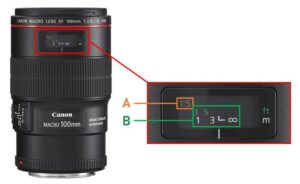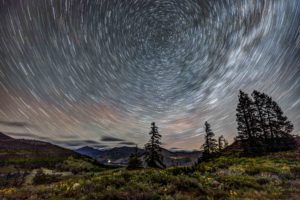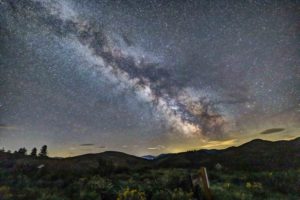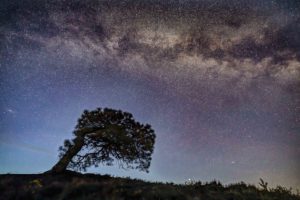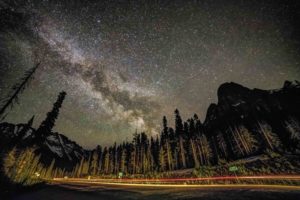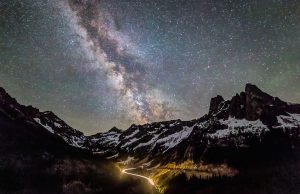NIGHT SKY PHOTO TOURS
Capturing Night Sky Images 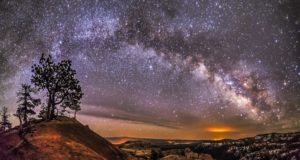
There is nothing more stunning than a clear image of the Milky Way Galaxy arcing overhead. The Majesty of the Galaxy is on display and you can feel yourself on the outer rim of the immense ring of stars…
By far, the most difficult part of capturing images of the Milky Way is simply getting there, at the right time!
When To Go
To get a good shot you need to go when there is NO moon in the sky. The moon reflects so much light from the sun that it washes out the Milky Way. Find a Lunar Calendar, the New Moon is when there is no moon in the sky, and you can get decent shots plus or minus 2 days from the New Moon. So, each month there is a 5 day window for Milky Way shots. The hard part of this, especially in Western Washington, is matching the New Moon with No Clouds!
Astrophotography with a DSLR
As far as capturing images like this goes, the equipment list is rather meager. You need a decent DSLR (a full frame body is best, but not mandatory) a wide angle lens ( 10 to 16 mm is best) a tripod and a cable release (or electronic shutter release) and that’s really all you need, equipment wise.
IF you are using a wide angle zoom lens, for example, a 16mm – 35mm lens, make sure to rotate the zoom ring and set it at its most wide angle setting, in this case, 16 mm. And don’t change it!
Once you get out to your spot  and get set up set the camera on manual exposure mode and open your aperture up all the way (use the lowest f/stop number) and then, using the chart here, set your shutter speed.
and get set up set the camera on manual exposure mode and open your aperture up all the way (use the lowest f/stop number) and then, using the chart here, set your shutter speed.
As for ISO, that is really the only variable. Depending upon your camera I would suggest starting at a relatively low ISO, say, 1,000 and then work your way up, checking the images as you go. Each camera will have its own ISO sweet spot, often its the mid point between the lowest and highest ISO setting on the camera.
Setting the Focus Manually
One more important item is focus. You must set your lens on Manual Focus. Auto focus will not work at night and so, before you head out, take some time and figure out how to manually set the focus ring on your lens to infinity.
There are several way to do this, one is look up your lens on line, looking for the manual, or advice as to how to set that lens to infinity.
What I suggest is to do are these steps: During daylight, with the camera in Auto Focus, Set the aperture all the way open and zoom out to its widest setting. Point the camera at something very far away. When you push the shutter button half way and the camera beeps: you’re focused! Now look at the lens focus distance window and note EXACTLY where it is set.
When you shoot at night set the lens on Manual Focus and adjust the focus ring as noted.
That’s it! Then you can leisurely move about, composing shots and have fun (make sure to check your focus ring from time to time, moving your rig about can often change the focus setting!)
As you recompose try different ISO settings and Viola! Nice shots.
Locations
To get decent images you need to get away from the lights of civilization. If you shoot near a city the entire horizon is washed out, no stars, or very faint. If you shoot in Eastern Washington, finding such a location is not difficult! These images were taken right behind Sun Mountain Lodge.
Generally you’ll be facing south to capture the galactic core (thickest part of the Milky Way) if as you scout for locations and think about foreground, keep that in mind!
Abandoned buildings are great for Night Sky, here is a shot from Eastern Washington.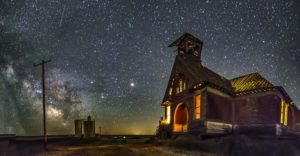
Photo Tours
If you are new to all of this its not a bad idea to go out with someone more experienced the first time and get the bugs worked out. I offer Night Sky Photo Tours. We meet and drive out to some location away from the lights of civilization where we can set up and get clear images of the stars.
Drive-In Night Sky Photo Tours – We will drive to a dark sky location and set up near the car to capture images. The meeting time changes with the season, but generally we would meet between 8 and 10pm, drive to our location, and return back home early the next morning. A Drive-In Night Sky Photo Tours is $200 per person.
Hike-In Night Sky Photo Tours: This is where we backpack in with our photo equipment and camping gear to a more secluded (and spectacular) location. This will give us a chance to capture Sunset and Sunrise images, as well as Night Sky pics! Contact me and we can discuss possible locations. A Hike-In Photo Tour is $300 per person.
Once we are there I will help mentor you as to all the basics: exposure, focus and composition to ensure that you get some awesome shots of the Milky Way.
- North Cascades Highway
- Picture Lake
- Liberty Bell from Washington Pass
Here are the available dates for Night Sky Photo Tours
Fill in the form and submit, I will be in touch and we can discuss details, possible locations, equipment and set a date.
Feel free to email me any questions at: Andyporterphotography@gmail.com
Night Sky Photo Tours are completely weather and cloud dependent! Clients can pay online or with cash when we meet in person.
$200.00
Buy now